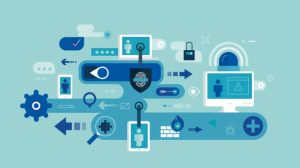In today’s digital age, where technology is deeply integrated into our daily lives and business operations, cybersecurity has become a paramount concern. With the proliferation of cyber threats, protecting sensitive information and systems is no longer an option but a necessity. Endpoint protection, in particular, plays a crucial role in safeguarding devices and networks from malicious attacks. However, despite its importance, there are several misconceptions surrounding cybersecurity and endpoint protection that persist. In this blog post, we’ll debunk some of these myths and shed light on the realities of securing endpoints and mitigating cyber risks.
“Endpoint Protection is Sufficient to Keep Systems Secure”
One common misconception is that deploying endpoint protection solutions alone is enough to ensure comprehensive cybersecurity. While endpoint protection tools such as antivirus software, firewalls, and intrusion detection systems are essential components of a robust security posture, they are not foolproof. Cyber threats are constantly evolving, and attackers employ sophisticated techniques to bypass traditional security measures. Therefore, organizations must adopt a multi-layered approach to cybersecurity, which includes network security, data encryption, user education, and regular security assessments.
“Small Businesses Are Not Targeted by Cybercriminals”
Another prevalent misconception is that cybercriminals only target large enterprises, leaving small businesses relatively safe. However, the reality is quite the opposite. Small and medium-sized businesses (SMBs) are increasingly becoming prime targets for cyber attacks due to several factors, including limited resources for cybersecurity measures, lack of awareness, and the perception of being easier targets. In fact, according to recent studies, over 40% of cyber attacks are aimed at SMBs. Therefore, it’s essential for businesses of all sizes to prioritize cybersecurity and implement robust endpoint protection strategies to safeguard their assets and data.
“Only IT Departments Are Responsible for Cybersecurity”
Many individuals believe that cybersecurity is solely the responsibility of the IT department or dedicated security professionals within an organization. While these teams play a crucial role in implementing security measures and responding to incidents, cybersecurity is a collective responsibility that involves every employee. Human error remains one of the leading causes of security breaches, whether through phishing scams, weak passwords, or inadvertent data exposure. Therefore, organizations must invest in comprehensive cybersecurity training and awareness programs to educate employees about best practices and the importance of maintaining vigilance in detecting and reporting potential threats.
“Endpoint Protection Slows Down Systems and Productivity”
Some people fear that implementing stringent endpoint protection measures will hinder system performance and productivity. While it’s true that poorly configured security solutions can impact system speed and user experience, modern endpoint protection technologies are designed to minimize such disruptions. Advanced antivirus software employs heuristic analysis and machine learning algorithms to detect and mitigate threats in real-time without causing significant slowdowns. Moreover, the productivity gains from preventing potential cyber attacks far outweigh any minor inconveniences caused by security measures.
“Once Installed, Endpoint Protection Can Be Forgotten About”
One of the most dangerous misconceptions is the belief that once endpoint protection software is installed, organizations can rest assured that their systems are secure indefinitely. In reality, cybersecurity requires continuous monitoring, updates, and adaptation to stay ahead of emerging threats. Hackers are relentless in their pursuit of vulnerabilities, and new attack vectors are constantly being discovered. Therefore, it’s imperative to regularly update endpoint protection software, apply security patches, conduct vulnerability assessments, and stay informed about the latest cybersecurity trends and best practices.
Debunking common misconceptions about cybersecurity and endpoint protection is essential for fostering a proactive and informed approach to cybersecurity. By understanding the realities of cyber threats and the limitations of security measures, organizations can better prepare themselves to mitigate risks and protect their assets and sensitive data. Remember, cybersecurity is not a one-time task but an ongoing process that requires diligence, collaboration, and a commitment to staying one step ahead of cybercriminals.






